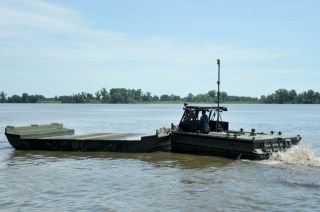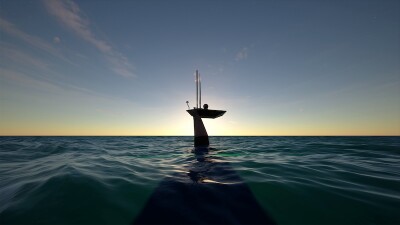The newest addition to the U.S. Army’s brownwater fleet was put through its paces last week at a Maryland proving ground, where the XM30 Bridge Erection Boat was demonstrated for top Army officials and Congressional staffers.
Built under a 2013 contract by Birdon America and its NAMjet propulsion subsidiary, now co-located in Denver, the 26’3”x8’ BEB provides propulsion and maneuvering for the Army’s floating ribbon bridges, used in combat zones and where fixed bridge crossings have been damaged or destroyed.
Over the next five years or so Birdon could build up to 374 boats, replacing the Army’s old Mk II BEBs in use since 1984, a total package worth up to $259 million. Visitors saw the system in action at the Army’s Aberdeen Test Center Amphibious Landing Area on Maryland’s Gunpowder River.
“It has a wide-beam hull that provides excellent load carrying capacity and stability. It’s stronger, faster, more reliable, much easier to operate and maintain,” said Frank Fleming, the Army’s BEB assistant product manager. “Maneuverability is greatly improved, and most importantly — crew survivability — the new boat also has ballistic protection for the crew.”
The design is based on boats Birdon Australia built for that country’s military, and Birdon set up its U.S. company to bid on the Army contract. In 2011 Birdon also acquired North American Marine Jet, and the renamed company builds the twin NAMJet Traktor Jet-381HH waterjets that go in each boat.
The waterjets are powered by a pair of 250-hp Cummins diesels, with multifuel capability to run on alternatives like JP-8.
Over land, the BEB rides on a heavy transport truck called the Common Bridge Transporter, along with Improved Ribbon Bridge (IRB) folded segments, called bays. Launched at the water’s edge, that combination can deploy up to almost 690 feet of IRB bays with the boat and its crew of two soldiers.
The IRB can handle trucks, weapons systems and tracked vehicles including tanks. For very wide crossings, IRB bays and BEBs can be mated up like river tows to float soldiers and equipment across.
“The BEB will support rafting operations in fast water and operates in high-particulate-matter environments, such as sand in the air, as well as in silt, in fresh, brackish, and sea water,” according to the Army Acquisition Support Center.
The BEB is key to those operations, said Rand Ponting, outgoing assistant product manager for the program, “because the boats actually assemble the rafts and bridges by maneuvering five- to seven-bay combinations of ramp and interior bays forward, reverse, and sideways in water where currents flow at speeds of up to six feet per second.”





